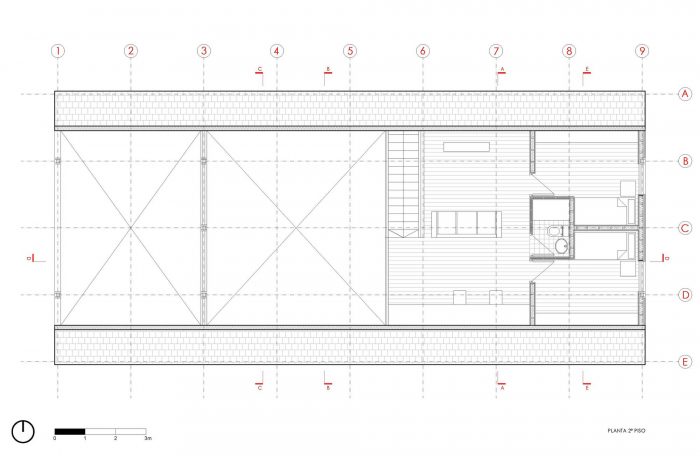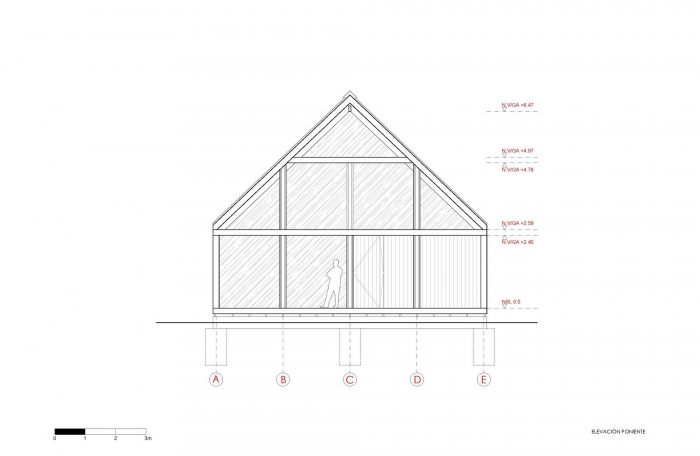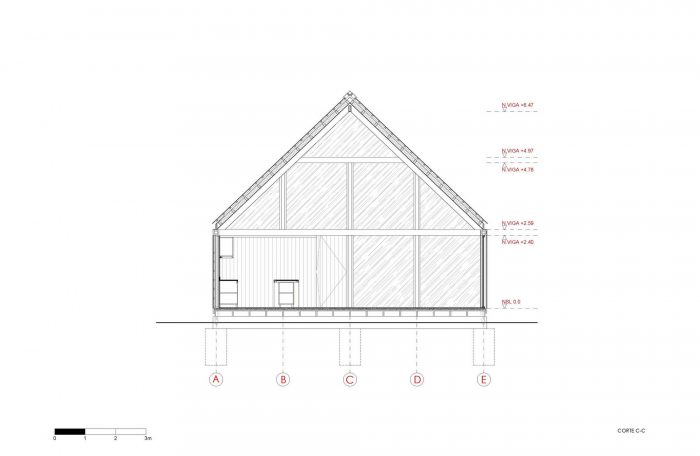该地点位于智利南部Llanquihue湖盆地的一片原始森林中。这个地区的特点是自然景观、茂盛的植被和寒冷/多雨的天气。为了定义房子的形象,它被作为参考,传统的类型学的棚的智利,这个地区的地方的身份的一部分。这些建筑被认为是由它的元素几何学与自然形成对比,并通过比例和纹理与之相关。该项目拯救了这种建筑及其结构系统的丰富性,以创造建筑的形象。
The site is located in a native forest, at the basin of the Llanquihue lake, in the south of Chile. This area is characterized by its natural landscape, lush vegetation and cold / rainy weather. To define the image of the house, it was taken as reference, the traditional typology of sheds of this region of Chile, which form part of the identity of the place. These buildings are recognized by its elemental geometry which contrasts with the nature and relates to it through proportions and textures. The project rescues the richness of this construction and its structural systems, in order to create the image of the building.
木材被用作覆层和结构。经过热处理的松木镶板、巴塔哥尼亚落叶松瓦和方木结构是天然的材料,与周围的自然一样,显示出时间的痕迹。景观被认为是这个地方的主角,正因为如此,为了让自然在背景中脱颖而出,我们提出了一个有限的颜色范围。房子被安置在南部的森林绿地,以segurate阳光和干预尽可能少的自然环境。入口和停车区被建议在房屋的南部,留下北部区域作为主要的自然空间。房屋结构由8.8米宽的部分组成,由木柱和桁架组成,相互之间的距离为2.4米。所建议的模块符合智利木材交易的标准格式。第一层的高度为2.4米,也是由标准的框架定义的,而桁架是建议的4米,这个措施允许占用这个结构,并解决了雨水径流问题。预计的结构定义了公共区域的特殊性。该通道由一个有盖的外部阳台配置,从那里可以到达房子的双层公共空间,考虑到一楼的客厅、餐厅和厨房,以及二楼的休息室。
The wood is used as cladding and structure. Heat-treated pine paneling, patagonian larch tiles and squared timber structures are natural materials that show the trace of time as the surrounding nature. The landscape is recognized as the protagonist of the place, because of this, it is proposed a limited range of colors for the purpose that nature stands out in the context. The house is sited in the south of a forest glade to asegurate the sunlight and intervene as little as possible the natural environment. The entry and the parking area are proposed at the south of the house, leaving the north area as the main natural space. The house structure is made up of a section of 8,8 mts. wide, composed by timber pillars and trusses distanced 2,4 mts. from each other. The proposed module responds to the standard format of the traded wood in Chile. The first storey is 2.4 mts height which also is defined by standard fomats, whereas the trusses is proposed 4 mts., this measure allows to occupy this structure and solves the rainwater runoff. The projected structure defines the speciality of the common area. The access is configured by a covered exterior terrace from where can be reached the double-height common space of the house that considers living room, dining room and kitchen on the first floor, and a lounge on the second floor.
主要的卧室和公共区域都是朝北的,以便利用阳光和景观。潮湿的建筑区域(厨房和浴室)集中在房子的南部,与森林有关。这种策略反映在面层上。北面是透明的,与自然环境有关,而南面则更加密封,有特定的窗户,解决了潮湿区域的通风问题。第二层是客房和通往公共空间的休息阳台。最后,在南面,垂直于房屋,有一个服务性的空间,它的中立性与主体量相呼应。
The main bedrooms and the public área are oriented to the north in order to take advantage of sunlight and views. Wet building areas (kitchens and bathrooms) are grouped in the south of the house, related to the denset forest. This estrategy is reflected in the facedes. While the north facede is transparent relating to the natural context, the south facede is more hermetic, with specific windows that solve the ventilation of the wet areas. In the second storey are located the guest bedrooms and the lounge balconied to the common space. Finally, to the south, perpendicular to the house, there is a service volumen whose neutrality operates as a counterpoint to the main volume.
建筑师:Duarte Fournies Arquitectos
面积:230平方米
年份:2019年
摄影:Pablo Casals Aguirre
制造商:Archicad, Artlantis, AutoCAD, CHC, CMPC, Casa Mobili, GLASSTECH, Maderas Rosas, Opendark, Volcan
牵头建筑师:Juan Pablo Duarte Macaya, Hernán Fournies Aracena
承包商:DF Constructora
合作者:Gonzalo Velásquez Fonseca
城市:Frutillar
国家:智利
Architects: Duarte Fournies Arquitectos
Area: 230 m²
Year: 2019
Photographs: Pablo Casals Aguirre
Manufacturers: Archicad, Artlantis, AutoCAD, CHC, CMPC, Casa Mobili, GLASSTECH, Maderas Rosas, Opendark, Volcan
Lead Architects:Juan Pablo Duarte Macaya, Hernán Fournies Aracena
Contractor:DF Constructora
Collaborators:Gonzalo Velásquez Fonseca
City:Frutillar
Country:Chile
























